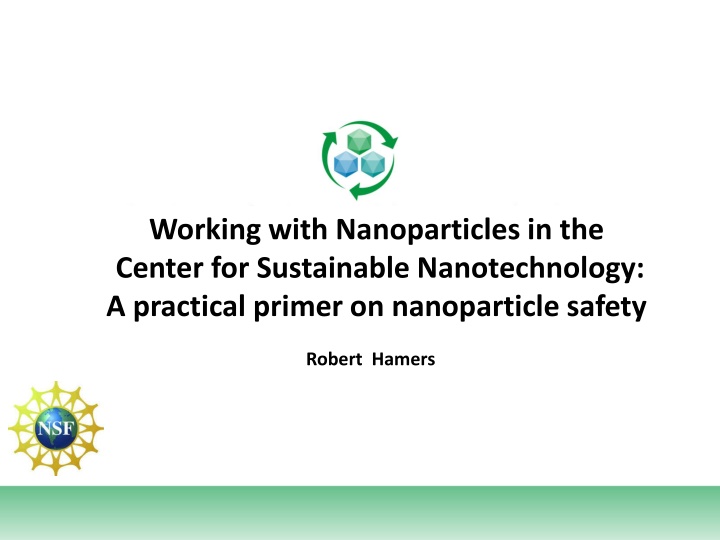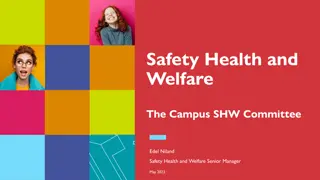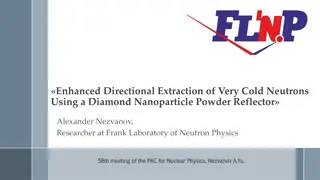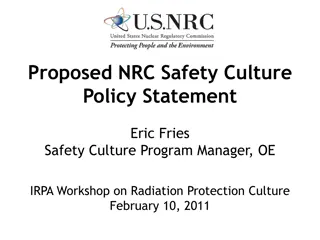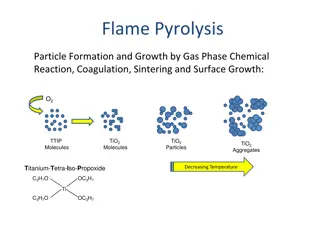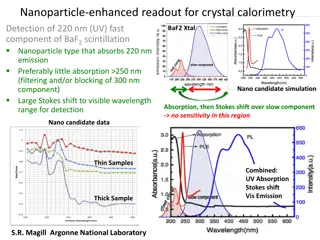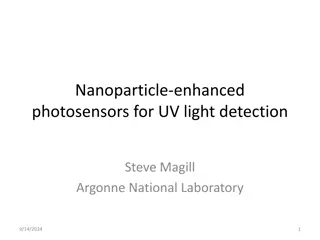Nanoparticle Safety and Health Impacts: A Practical Overview
This primer discusses the safety aspects of working with nanoparticles, emphasizing the unknown properties and potential health effects. It covers routes of exposure, inhalation hazards, and examples of incidental nanoparticles impacting human health. The content stresses the importance of researchers implementing effective safety procedures in the laboratory environment to minimize exposure risks.
Download Presentation

Please find below an Image/Link to download the presentation.
The content on the website is provided AS IS for your information and personal use only. It may not be sold, licensed, or shared on other websites without obtaining consent from the author.If you encounter any issues during the download, it is possible that the publisher has removed the file from their server.
You are allowed to download the files provided on this website for personal or commercial use, subject to the condition that they are used lawfully. All files are the property of their respective owners.
The content on the website is provided AS IS for your information and personal use only. It may not be sold, licensed, or shared on other websites without obtaining consent from the author.
E N D
Presentation Transcript
Working with Nanoparticles in the Center for Sustainable Nanotechnology: A practical primer on nanoparticle safety Robert Hamers
Acknowledgment This module is based in part on an 8-hour NP safety training course available at: https://nanohub.org/groups/gng/training_mate rials It has been shortened and adapted to meet the needs of CSN students/postdocs working with small (gram-scale or less) amounts of nanomaterials.
The Starting Point: Nanoparticles may have unknown properties Many nanomaterials being used in the CSN have not been investigated extensively for human toxicity. There are no procedures or equipment that are guaranteed to keep users safe The amounts of materials being used are typically small enough that exposure and associated can be minimized It is every researcher s responsibility to determine effective safety procedures appropriate to your own laboratory environment and exposure/use patterns.
Incidental Nanoparticles Health Effects Human Origin (Incidental) Health Impacts Cooking smoke Pneumonia; chronic respiratory disease; lung cancer Diesel exhaust Cancer; respiratory disease Welding fumes Metal fume fever; infertility; benign pneumoconiosis Industrial emissions/effluents Asthma, atherosclerosis, chronic obstructive pulmonary disease Sandblasting Silicosis
Routes of Exposure: Inhalation Inhalation has been a major focus of the nanotoxicology community; NP penetration into the lung depends on its aggregation state Airborne NPs can be inhaled and deposit in the respiratory tract Inhaled NPs may enter the blood stream and translocate to other organs >10 microns: stopped by mucous Small NPs can penetrate deeper and block alveoli Image: http://upload.wikimedia.org/wikipedia/commons/3/36/Respiratory_Tract.png
Inhalation Hazards Certain nanomaterials can Induce cancers, including mesothelioma Cause rapid and persistent pulmonary fibrosis Cause cardiovascular dysfunction Migrate along the olfactory nerve into the brain Alveolar Epithelial Penetration by Multi-walled Carbon Nanotube Courtesy of R. Mercer, NIOSH
Routes of Exposure: Dermal (Skin) Available data are limited and often conflict; Skin cannot be ruled out as a potential route of exposure Several studies show little to no penetration of nanoscale oxides beyond surface skin layers Polysaccharide and metal nanoparticles have been shown to penetrate flexed, damaged or diseased skin Quantum dots were found to penetrate intact pig skin within 8-24 hours at occupationally relevant doses
Dermal Hazards Various nanoparticles have been shown to Inhibit cell proliferation (iron oxide, nanotubes, TiO2, silver) Affect cell morphology (silver, nanotubes) Initiate irritation response (quantum dots, nanotubes) Damage cell membrane (fullerenes) Induce DNA damage (cobalt chrome alloy)
Routes of Exposure: Ingestion Ingestion is a viable route of exposure; Ingested nanoparticles can translocate throughout the body Ingestion may occur after inhalation exposure when mucus is brought up the respiratory tract and swallowed. Poor work practice can result in hand-to- mouth transfer Ingested nanoparticles do translocate to other organ systems SWCNT delivered into gut for treating Alzheimer s disease were found in liver, brain and heart Ingestion of colloidal silver can result in permanent discoloration of skin, nails and eyes
Ingestion Hazards Various nanoparticles have been shown to Slightly damage liver (silver) Trigger immune response in intestinal dendritic cells (TiO2 and SiO2) Be cytotoxic to human intestinal cells (TiO2, SiO2 and ZnO) Damage DNA of human intestinal cells (ZnO) Be genotoxic to liver and lungs after oral adminstration (C60 and SWNT)
What do we know about Nano-tox? Much of the early nanoEHS research has focused on simple systems of limited relevance to human health (e.g., cytotoxicity) Some nanoparticles can translocate throughout the body after exposure via inhalation, contact with skin or ingestion Some nanoparticles can induce unwanted health effects in animals or cell cultures It makes sense to control exposure to those nanomaterials for which preliminary hazard data show unwanted health effects or hazards are unknown
Airborne Exposure: How much protection do I need? Many nanoparticles of interest in the center have not been explicitly studied In some cases, recommended threshold limits for exposure are available in public databases DOE Protective Action Criteria: http://www.atlintl.com/doe/teels/teel.html (database for 60-minute exposure levels) NIOSH Permissible Exposure Limits (PEL): https://www.osha.gov/dsg/annotated-pels/ Different tables for short-term acute exposure, chronic exposure as part of an 8- hour day, etc. These will differ by orders of magnitude, so make sure you know what you re looking at.
Example materials within the CSN: LiNiMnCoO2( NMC ) (Ni, Co, Mn?, Li) LiCoO2 LCO (Co) CdSe quantum dots (Cd, Se)
Example 1: Nickel Immediate Danger To Life and Health (IDLH) Threshold Limit Values (TLV) Permissible Exposure Limits (PEL,REL) http://www3.epa.gov/airtoxics/hlthef/nickel.html Recommended exposure limit 0.015 mg/m3 (averaged over 8 hour day) 1 mg/m3 (short-term)
Example 2: Cobalt http://www3.epa.gov/airtoxics/hlthef/cobalt.html Recommended 8-hour daily limit, 0.02-0.05 mg/m3
Example 3: Cadmium (e.g., CdSe QDs) 30 min 8-hr day Recommended 8-hour daily limit, 0.002 mg/m3 airborne dust 30-minute limit: 9 mg/m3 http://www3.epa.gov/airtoxics/hlthef/cadmium.html
Some CSN-relevant exposure limits: (8-hour day) Li: 4 mg/m3 Ni: 0.015 mg/m3 Co: 0.02 0.05 mg/m3 Cd: 0.002 mg/m3 Now we have some knowledge of how much is safe . Next Questions: How much is a typical batch of nanoparticles? How much is likely to get dispersed into the air? How effective must our respiratory protection be? http://www3.epa.gov/airtoxics/hlthef/ *Sittig's Handbook of Toxic and Hazardous Chemicals and Carcinogens
Consider an example: Typical lab: 20 ft x 30 ft x 10 ft = 6000 ft3= 170 m3 Assume 10 mg dispersed into 170 m3 0.06 mg/m3 (assuming no air exchanges, stagnant air) In reality, air changes 4-12 times per hour in typical laboratory room. Assume 4 times/hr, 8 hrs = 32 exchanges 8-hour time-averaged concentration=.06/32 mg/m3 = 0.002 mg/m3 This value is comparable to the recommended exposure limit for Cd (assuming 8 hours/day exposure on a continuous basis) In most cases, the amounts of materials behind handled within the CSN are small enough that it is unlikely to exceed OSHA standards. Those making materials will always have some additional risk of exposure. Plan for the worst and build in extra protection.
Hierarchy of protection Global protection Elimination Policy & Regulatory controls Substitution CSN Modification Engineering controls Lab-scale protection Containment Ventilation Work Practices Individual controls Individual protection Personal Protection Adapted from http://www.cdc.gov/niosh/topics/ctrlbanding/images/hierarchy_of_controls.jpg
We need to consider these factors mild / reversible severe / irreversible Occupational Health Hazard kilograms 8 hours Engineered Local Exhaust Ventilation Task Duration Quantity Closed Systems milligrams 15 minutes slurry/suspension agglomerated highly dispersed Physical Form 4-20 Courtesy NIOSH
Elimination Substitution Engineering Controls: Containment Modification Containment What are some examples of containment for nanoparticles? Ventilation Work Practices Personal Protection 4-21
Nanoparticles are often provided and worked in a wet state to reduce the risks of airborne exposure Photo courtesy Mark Methner, NIOSH
Glove boxes Glove boxes of this type are often positive internal pressure, such that a pinhole in a glove will push the internal contaminants toward you (not good) Low air current facilitates weighing operations compared with regular fume hood
Ventilated Workflow At PNNL: All dry nano work must be performed in special Nano hood Air flow pulled into box, with ULPA 99.999% efficient on 120 nm particles (Labconco Xpert Nano ) Cost ~ $6k
Elimination Engineering Controls: Ventilation Substitution Modification Containment What are the two main divisions? Ventilation Work Practices 1) dilution ventilation 2) local exhaust ventilation Personal Protection 4-25
Dilution ventilation (typical laboratory and office air supply) supplies some outdoor air, but mostly recycles room air. 4-26 Graphic courtesy EPA
Chemical Safety hoods Air is sucked into the hood and out through exhaust (to roof of building) Most common protection in chemistry laboratories Presumably NPs aggregate during the process.
Nanoparticle Filtering systems Industrial nano reactor This unit has HEPA filters on the exhaust system to capture NPs. (HEPA= High Efficiency Particular Air . more on HEPA filters later..) Courtesy Oak Ridge s Nanophase Materials Research facility
Airborne NP removal by HEPA filtration HEPA= High Efficiency Particle Air HEPA filtration media www.asbestosguru-oberta.com http://www.nanoscience.com/applications/fibers/image-gallery/
HEPA filters work for NPs too ! HEPA filter must be >99.97% effective at removing 300 nm diameter nanoparticles. This is the most difficult size to trap, so HEPA filters are even more effective at removing smaller NPs. Used HEPA filters must be handled carefully. http://blogs.cdc.gov/niosh-science-blog/2009/10/14/n95/ 4-30
Administrative Controls: Work Practices Elimination Substitution Modification Containment Ventilation Work Practices Personal Protection What practices could make a difference?
Work Practices: Keeping NPs away! Lab benches: Wet-wiping counters (bag used wipes before disposal!) HEPA-vacuum lab benches Floors: HEPA vacuum Web-mopping Sticky mats Source: NIOSH and Oak Ridge National Laboratory 4-32
Sticky mats Sticky mats come in packages of ~ 30 mats/pad, usually sold a a set of 4 pads Large (3 x 5 ) mats cost: ~$1 per mat 1-year cost with daily replacement about $350
Elimination Substitution Personal Protective Equipment Modification Containment Ventilation Why is PPE at the bottom? Work Practices Personal Protection 4-34
Personal Protective Equipment Overview Which level do you think we may need for handling nanoparticles?
Appropriate Protection Body Hands Eyes Foot Respiratory
Hand protection Small nanoparticles may enter the body through the skin NIOSH recommends wearing gloves whenever handling nanopartilces Nitrile (most generally used) Neoprene Polyvinyl chloride (PVC) Latex Nitrile gloves 4-37
Eye Protection Eye protection with splash shields is standard practice in any laboratory and should always be used. Goggles are even better. Sometimes eye protection is combined with respiratory protection Must meet ANSI Z-87.1 4-38
Body protection: Lab Coats Disposable Tyvek lab coats ~$5.-10 each Re-usable (washable) labcoats Tyvek labcoats provide much better protection against nanoparticles but can melt upon exposure to flame http://www.safetysupplyamerica.com/p-2989-tyvek-lab-coat-snap-front-collar-no-pocket- 30case.aspx https://depts.washington.edu/chem/courses/images/coat.jpg
Respiratory protection Respirators may be required or recommended for some nano operations when engineering controls cannot reduce NP exposure to an acceptable level. In a commercial setting, OSHA s standard (1910.134) would apply, requiring: Written program Training Medical evaluation Fit testing Respirator maintenance program
Respirators are classified by 2 parameters Effectiveness Oil Resistance N Not resistant 95% 99% 100% (>99.97%) = HEPA x R Resistant P Oil Proof Oil resistance rating is important in many manufacturing settings, but unlikely to be important in CSN lab environments. N and P are both commonly found Tested with 300 nm NaCl (N) and/or dioctylphthalate aerosol (R,P)
Example disposable particle respirators N95 N99 N100 Moldex 2310 3M 8233 99.97% capture $10.00 each 3M 8511 $2.50 each $5.00 each Examples taken from web site of Cooper Safety http://www.coopersafety.com/
Cartridge-style respirators: Full-face Half-face 3M P7500 respirator ($35.00, +$10 for replaceable cartridges) Cartridge-style filters are more effective than disposable dust-mask style filters due to improved fit around bridge of nose. OSHA considers full-face respirators to be 5x more effective than half-face respirators because of the improved fit around forehead instead of bridge of nose EPA requires full-face N-100 cartridge respirators for CNT manufacturers unless they prove no exposure https://multimedia.3m.com/mws/media/565214O/3m-cartridge-filter-guide-and-brochure.pdf
Proper fitting to OSHA standards is a complicated process that includes reading about pots of gold at the end of the rainbow (really!) * If you do not properly fit the mask to your face you will not get the expected protection. Common disposable N95 filters are difficult to fit properly around the nose and chin. *https://www.osha.gov/pls/oshaweb/owadisp.show_document p_table=STANDARDS&p_id=9780 A simpler but less rigorous test: https://www.youtube.com/watch?v=eVgXTXKc5A8
Effective use of respirators Effectiveness of respirators hinges on having a good fit to the face. There are ways of testing this. OSHA does not allow use of repirators with beards. All respirator users must be clean-shaven Filters need to be replaced at an appropriate interval (when difficult to breathe, or on regular basis of ~30 days) https://multimedia.3m.com/mws/media/565214O/3m-cartridge- filter-guide-and-brochure.pdf
NIOSH has developed a selection logic that can be applied to nanoparticles http://www.cdc.gov/niosh/docs/2005-100
Prudent Practices: Safety is Everyones Responsibility Safety is everyone s responsibility Failure to maintain good safety procedures could endanger your lab-mates as well as yourself Proper safety procedures will vary with local lab environments and available engineering protections (hoods, etc.) Nobody can keep you safe but yourself!
Prudent Practices: Know your materials! Know what you have If available, read MSDS and be familiar with chemical properties Recognize that we may be working with materials with unknown or poorly documented chemical toxicity and reactivity.
Prudent Practices: Minimize airborne exposure Clean up nanoparticle work areas frequently using wet wipes Clean up any solid spills immediately using wet wipes Wet-mop lab floors or use sticky-mats Dispose of NP-contaminated waste safely as per local rules/regulations
Prudent Practices: Wear proper lab attire Closed-toed shoes Long pants (Tyvek?) Lab coat Goggles Gloves Possibly work with respirator if working with dry nanoparticles in large quantities.
